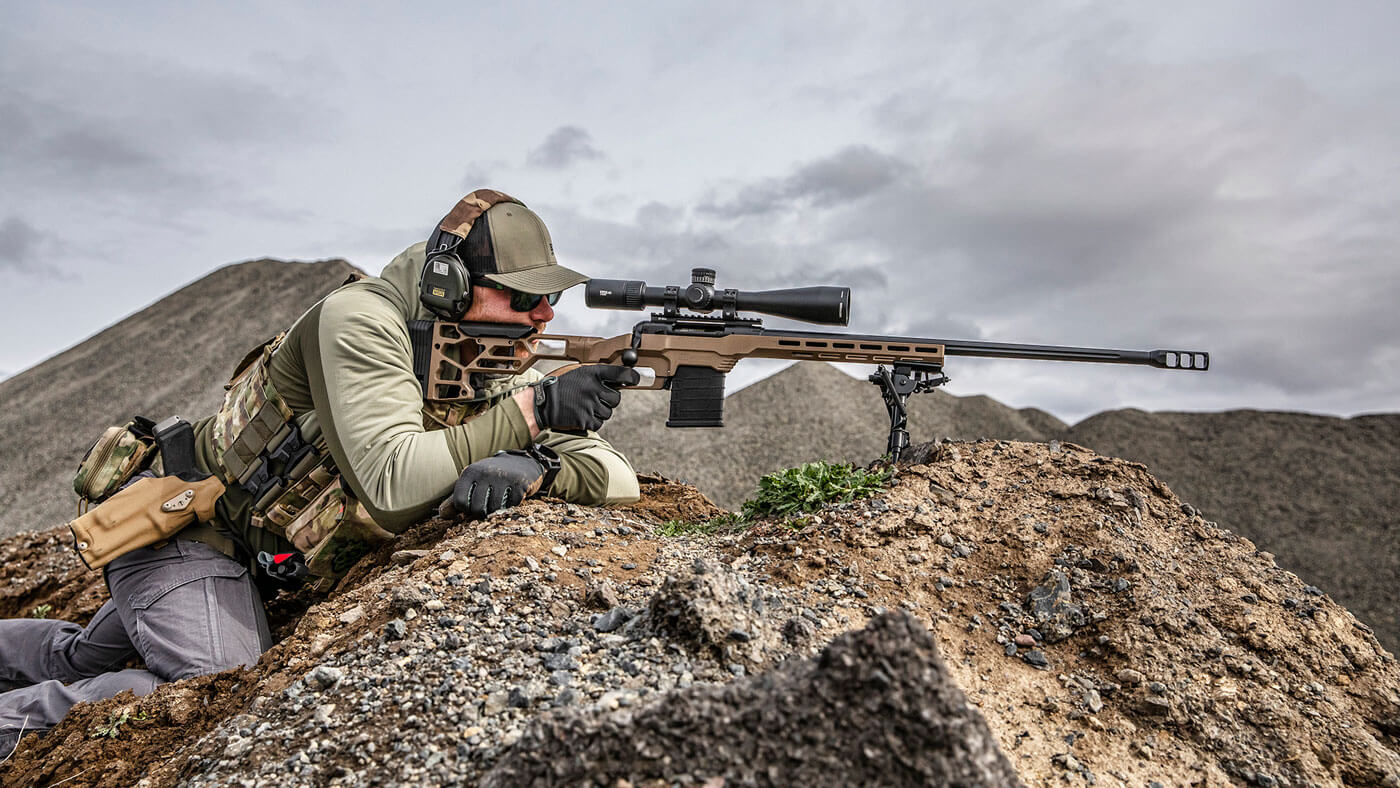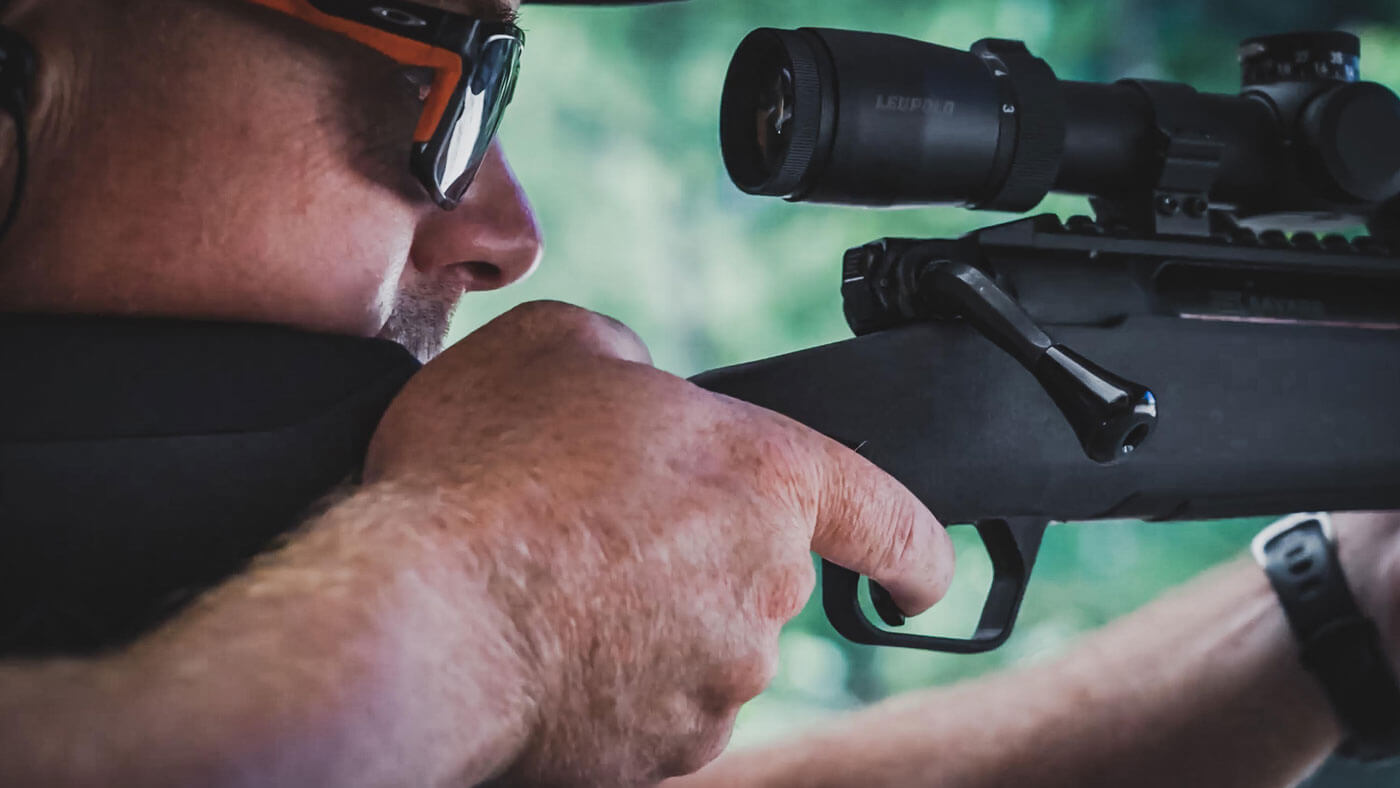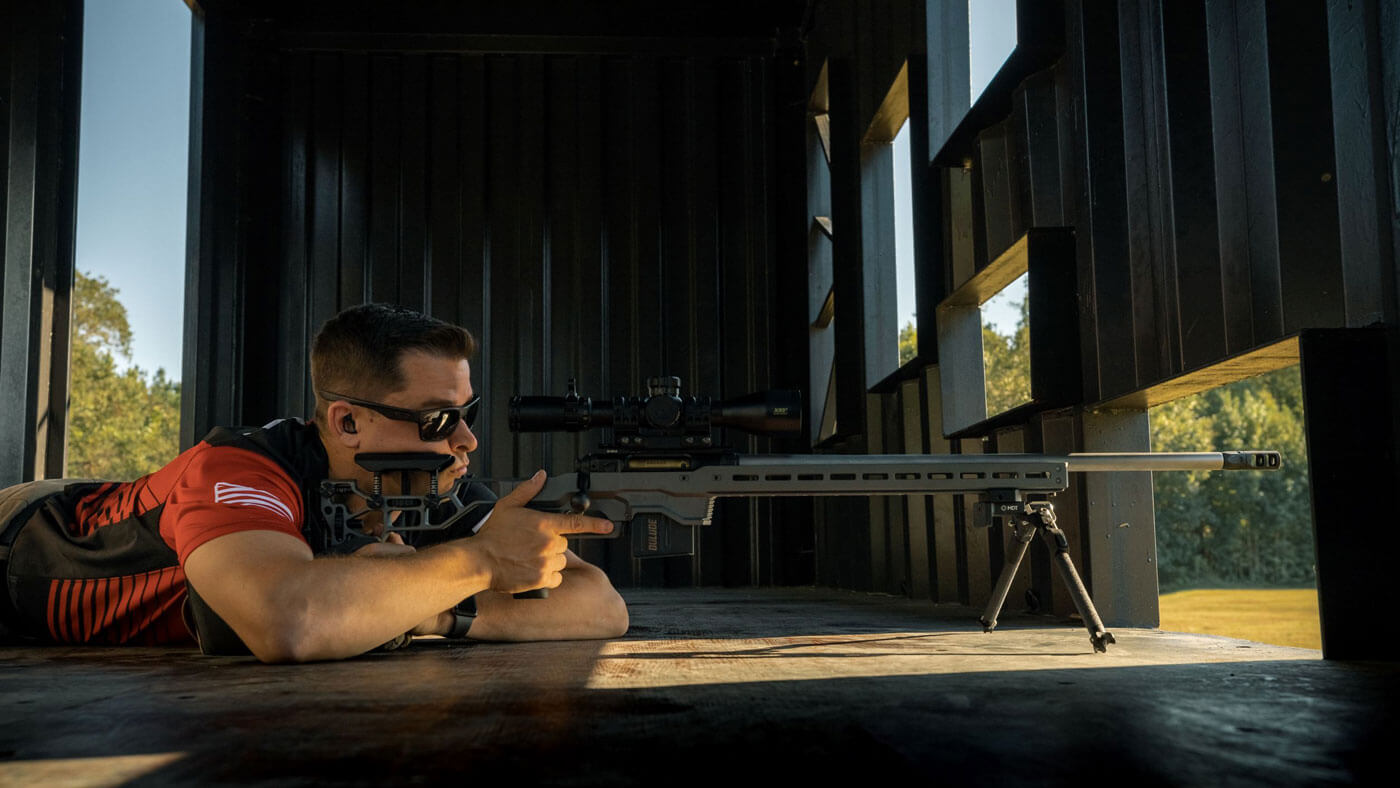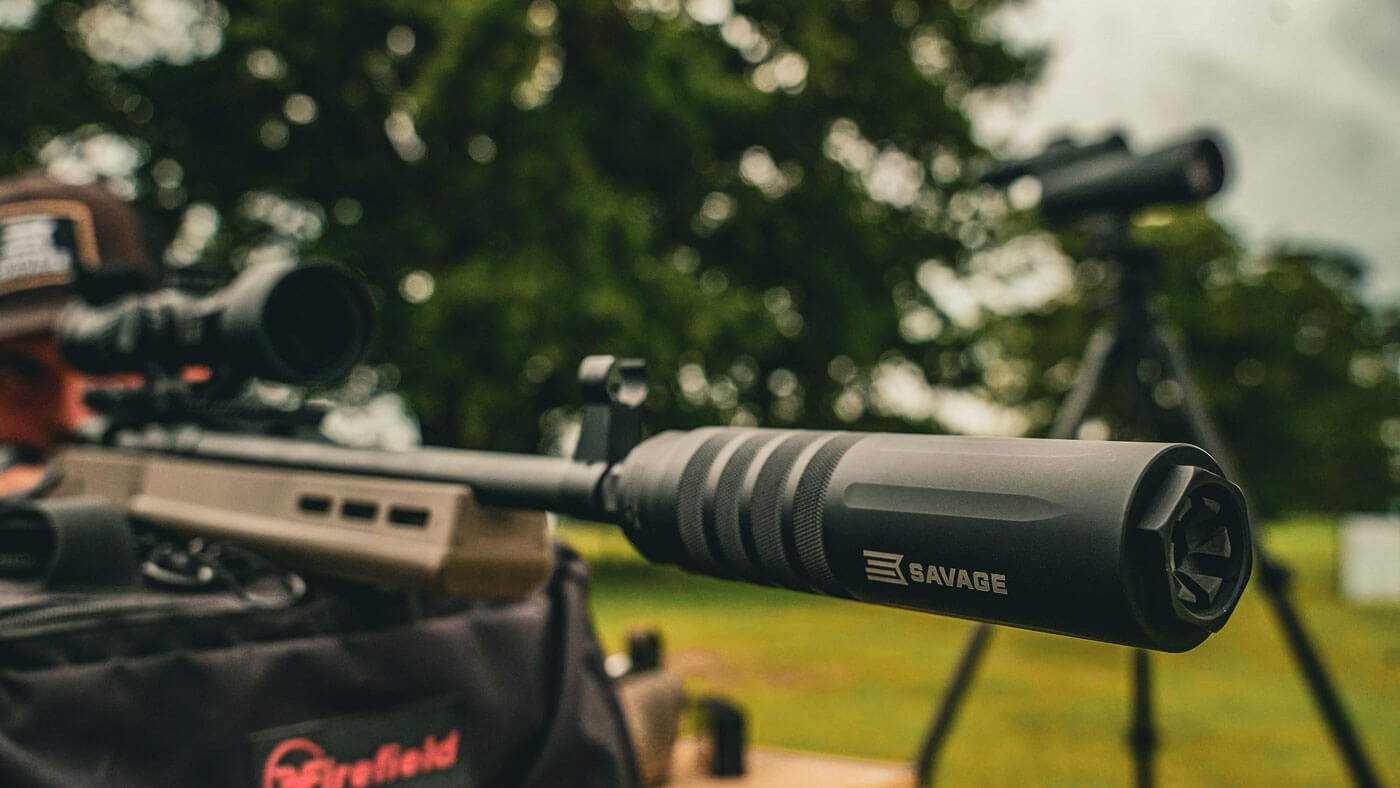- Savage Blog
- Long-Range Shooting Fundamentals: The Basics of Precision
Long-Range Shooting Fundamentals: The Basics of Precision

Long-range shooting isn’t just about having the best rifle or optics; it’s about refining your shooting mechanics to maximize accuracy and consistency. Your body is an integral part of the shooting system, and mastering your long-range shooting fundamentals can mean the difference between a first-round impact and a frustrating miss. In this guide, we’ll break down the physical aspects of long-range shooting—trigger control, breathing, body positioning, and additional fundamentals like grip, recoil management, and follow-through. We’ll also provide practical training tips to help you refine these skills both on and off the range.
Trigger Control: The Foundation of Precision
The way you manipulate the trigger is one of the most critical aspects of long-range shooting fundamentals. A smooth, consistent trigger pull ensures minimal disturbance to your sight picture, prevents unintended deviation of the rifle, and ensures repeatable, consistent accuracy.
Key Elements of Trigger Control:
Finger Placement: Place the pad of your index finger on the face of the trigger, ensuring it rests naturally without excessive force.
Straight Pull-Back: Apply pressure straight to the rear, avoiding lateral movement that could affect shot placement.
Consistent Pressure: Use a steady squeeze rather than jerking or slapping the trigger. Be careful not to jerk the trigger when you hit the “wall” before the shot breaks. Keep applying consistent pressure through the trigger pull.
Follow-Through: Keep pressure on the trigger until after the shot breaks, allowing the rifle to settle naturally. The shot should almost surprise you, and flinching or expecting the shot can negatively affect your accuracy.
The Role of an Adjustable AccuTrigger:
Many modern precision rifles, such as those from Savage, come equipped with an adjustable trigger. At Savage, we pioneered a safe and adjustable trigger with the user-adjustable AccuTrigger. This feature allows shooters to fine-tune the trigger pull weight to match their preference, reducing unnecessary movement during the shot. A lighter, crisper break reduces the likelihood of disturbing your sight picture and improves precision. Practicing with a properly adjusted trigger can significantly improve shot-to-shot consistency. The AccuTrigger on many Savage precision rifles can be adjusted to break as low as 1.5 pounds, perfect for helping to improve the accuracy of your shot.

Training Tips:
Before training indoors with your firearm, make sure that your firearm is unloaded with the magazine removed.
Dry Fire Drills: Use a coin or spent casing on the barrel and dry fire while keeping it steady. If the object on your barrel moves, it is an indication that you are jerking or slapping the trigger instead of squeezing it.
Wall Drill: Aim at a blank wall and focus on breaking the shot without disturbing the sight picture. Some companies make laser training aids that can help visualize how your shot breaks.
Slow-Fire Live Practice: Fire multiple rounds with slow, deliberate trigger pulls, analyzing shot-to-shot consistency.
AccuTrigger Adjustment: Experiment with different trigger pull weights to find which weight is most comfortable for you to shoot. Some shooters prefer a lighter trigger pull, while others prefer a heavier trigger pull, so find what works best for you!
Breathing Control: Enhancing Stability and Consistency
Breathing affects your body's natural movement and can introduce inconsistencies in shot placement if not controlled properly. Mastering a breathing rhythm is a core piece of your long-range shooting fundamentals, and ensures your body remains stable and allows for a smooth trigger break and accurate shot.
Proper Breathing Technique:
Having proper breath control is just as important to precision shooting as proper trigger control. With controlled breathing, you can help calm your body and give yourself a more stable platform from which to shoot. Here’s there’s the technique you should follow:
Breathe in with a slow, controlled breath.
Begin to exhale, pausing about halfway through to make your body completely still.
When your sight picture is stabilized and on target, pull the trigger with a smooth, consistent pull until it breaks.
After the shot breaks, finish exhaling.
Make sure you don’t hold your breath for too long! Holding your breath on the exhale for too long can increase your heart rate, causing you to become fatigued and jittery, making your body and trigger pull unstable.
Training Tips:
Box Breathing: To practice box breathing, inhale for four seconds, hold for four seconds, exhale for four seconds, hold again, and repeat.
Timed Breath & Trigger Squeeze: Sync your breathing pattern with your trigger squeeze for improved control and accuracy. If you train your pull to begin as you pause to exhale, it will become second nature and easier to perform consistently.
Cardio-Induced Shooting: Engage in short bursts of physical exertion before shooting to simulate high-stress conditions and practice breath control. This is especially useful for training for defensive situations or high-stress hunting scenarios.
Body Positioning: The Key to Stability and Repeatability
Your shooting position plays a major role in recoil management and shot-to-shot consistency. A solid, repeatable position allows you to maintain a natural point of aim and minimizes unnecessary movement. Out of all the shooting positions, the prone position often provides the most stable platform for shooting.
Optimal Prone Position:
Straight Alignment: Your body should be aligned directly behind the rifle, not off to the side.
Even Pressure Distribution: Your elbows should provide natural stability without excessive muscle tension. Try using a shooting bag for the rear of your rifle for even more help with stability and to help distribute the pressure.
Stock Contact: Maintain consistent cheek weld and contact between your shoulder and your rifle’s buttstock.
Leg Position: Spread legs slightly, about shoulder-width apart, with your feet relaxed to absorb recoil naturally.
Training Tips:
Dry Fire in Position: Spend time dry firing in prone, kneeling, and other supported positions to build muscle memory.
Recoil Management Drills: Fire slow, deliberate rounds and observe how your rifle reacts under recoil. Note your rifle’s muzzle climb and drift, and how you can improve that with trigger control.
Natural Point of Aim (NPA) Test: Close your eyes, settle into position, and open your eyes—if your sights drift, adjust your position until they stay on target.

Additional Fundamentals for Long-Range Accuracy
Grip & Rifle Control
Maintaining a proper grip on your rifle is crucial to accuracy. Your grip should be firm, but not so tight that it induces tension in your shooting hand or wrist. If your hands, arms, or body are too tense, you can twist your rifle slightly and cause inaccurate shots.
Support Hand Placement: Your support hand should be used to adjust rear bag positioning for micro-corrections. If you don’t have a rear shooting bag, use your support hand to help stabilize the rear of the rifle by placing your hand underneath the buttstock as a support with your elbow in the ground.
Consistent Grip Pressure: Apply uniform grip pressure to avoid shot variance. Too much pressure can cause an inconsistent shot from torque applied to the rifle.
Accessorizing: Don’t be afraid to get some help to make your rifle more stable. Adding a bipod can help increase the stability of your rifle and make focusing on your fundamentals easier for more consistent shots.
Recoil Management
Recoil management ensures that the rifle returns to the same point of aim after each shot. A shooter who anticipates recoil will often “flinch”, or jerk the trigger due to anticipating the shot, disrupting accuracy.
Lean into the Rifle: Shift body weight slightly forward to control recoil. This will help you better absorb the recoil by utilizing your body as a counterbalance to the force of the recoil.
Firm Shoulder Contact: Maintain consistent pressure between the buttstock and your shoulder pocket. You should be pressing the rifle into your shoulder to achieve firm, consistent contact.
Spotting Your Shots: With proper recoil management, you should be able to see your bullet impact through the scope. If your shot is off, this will help you make your corrections to the shot. Make sure you don't use too much magnification to make spotting your impacts or misses easier. If your target takes up the majority of your scope, you're zoomed in too far!
Muzzle Devices: Using a muzzle device can help reduce felt recoil from the shot, which is a big plus for new shooters or those sensitive to recoil. Adding a muzzle brake, or a suppressor like the Savage AccuCan, can help make a world of difference in improving your precision shooting.

Follow-Through
Follow-through is maintaining proper technique after the shot breaks. Many shooters tend to lift their heads off the stock or release trigger pressure too soon after the shot breaks, which can cause inaccurate shots if you get used to pulling your head or letting off the trigger too soon.
Stay on Target: Keep your eye looking down the scope until your shot has impacted the target and you’ve had time to take note of where your shot hit.
Hold Position: Don’t move until confirming your shot placement. This will help you make accurate corrections by having your reticle in the same place before, during, and after the shot.
Let off Your Shot: When you let off your shot after the trigger breaks, let off the trigger smoothly until you hear and feel the click of the trigger resetting. At this point, you’re ready to squeeze the trigger again for another shot.
Maintaining Mastery: Off-Range Drills for Continuous Improvement
Even when you can’t get to the range, you can maintain and refine your long-range shooting fundamentals through these exercises:
Trigger Control Practice: Use a dummy gun or dry fire at home. If you’re dry firing at home, make sure your firearm is unloaded with the magazine out. You can also use snap caps, or fake ammunition, while you are dry-firing.
Breathing Training: Incorporate controlled breathing exercises into daily routines, or set aside time to practice your breath control.
Positioning Drills: Set up in different shooting positions and practice mounting your rifle to get a clear and consistent sight picture.
Recoil Management Strength Training: Engage in core and upper body exercises to enhance stability under recoil.
Grip & Hold Drills: Practice gripping an unloaded rifle to reinforce consistency. Take notes of times you are squeezing the rifle too hard and the effect is has on your sight picture.
Long-range shooting is a discipline that demands more than just good equipment—it requires complete control over your body mechanics. Mastering trigger control, breathing, body positioning, grip, recoil management, and follow-through will enhance precision and consistency at longer distances. By incorporating focused training both on and off the range, you’ll build the muscle memory and control needed to perform when it counts.

Precision comes from practice—so get out there, refine your fundamentals, and keep sending it downrange!

